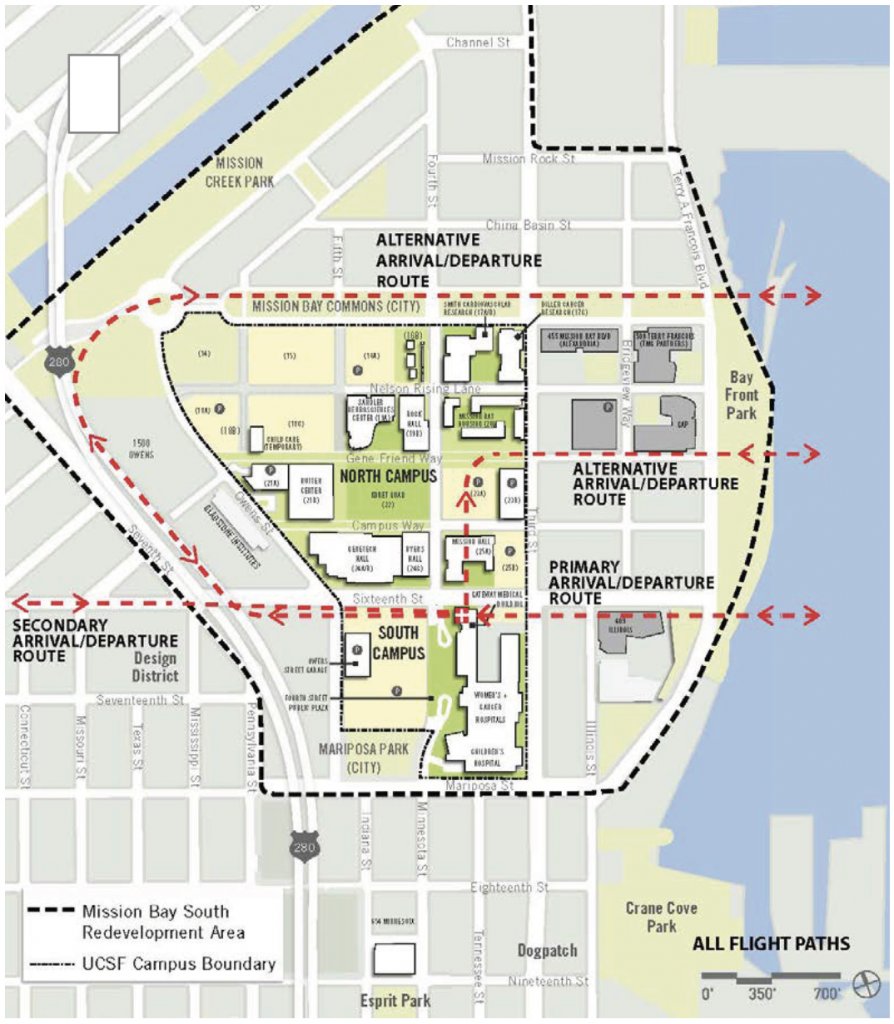
The helicopter flight path to the University of California, San Francisco’s Mission Bay campus was altered this past summer due to construction activity at the Chase Center, the site of the Golden State Warriors’ new home. However, after a decade of community debate about noise and potential crashes leading up to the helipad opening along with the UCSF Medical Center in 2015, the helicopters have barely drawn attention since. The new path has largely gone unnoticed.
“Ten years ago, the talk about it was really alarming, so people were upset,” said Mikael Wagner, a Dogpatch community representative on the Helipad Advisory Committee. “But we thought we’d give it a chance, and then we didn’t really hear it when it came. Also, we talked about it and we decided it is really about saving lives and we thought that was more important for the community.”
The previous flight path called for helicopters to arrive from the east over 16th Street from the Bay to the Medical Center’s northwest corner. The deviated pattern has them flying over Mission Bay Boulevard, hugging Route 280 and approaching the Center from the west, departing along the same path. The alternative route was part of the Federal Aviation Administration-approved proposal when the helipad opened.
According to Michele Davis, UCSF spokesperson, the route change was prompted by several towering cranes at the Warriors site, which is east of the Medical Center, between 16th and South streets. “Prior to this construction activity, and after completion, we anticipate resumption of the primary flight path to and from the east,” she said.
When the helipad became operational, UCSF promised that noise wouldn’t rise above 95 decibels outside and 80 decibels indoors. That’s slightly louder than airplanes that pass over Mission Bay, but on par with motorcycles and louder trucks. UCSF offered to pay for sound reduction inside the homes of nearby residents if levels were to reach those numbers. Community members had until July, 2016 to request a test. According to Davis, no applications were filed.
The current path takes copters over offices and the Family House, which provides housing for relatives of hospitalized children. Employees at two restaurants located along the primary path, STEM Kitchen and Garden and Mission Rock Resort, told the View that the helicopters have been heard, but aren’t bothersome. A visit to the area revealed that, in the daytime at least, noise from construction machinery and generators at the Chase Center, UCSF and a new housing development to the south of the hospital masks sounds from helicopters.
The helipad was primarily established for emergency transport of children and pregnant women to Benioff Children’s Hospital, located at the southern wing of the Medical Center. Davis said those conveyed by air have included a child with a heart defect that required immediate surgery to survive; a child in septic shock and organ failure who could’ve otherwise died within hours; and a pregnant woman with life-threatening preeclampsia. The helipad isn’t used for trauma transport, such as car accident victims.
UCSF has just one helicopter in its fleet, painted red, white and baby blue and dubbed “Bear Force One.” It’s the only emergency copter in use in San Francisco. The San Francisco Police Department shut down its aerial division after crashes in the 1970s and 1990s. However, UCSF partners with other aerial medical transport companies, including REACH, Med-Trans and CALSTAR, which access the helipad.
The helipad is open 24 hours daily, with an average of one to two flights per day. “Although there are days when there are no flights, during the winter months we seem to experience an increase due to the high number of children suffering respiratory emergencies during flu season,” said Davis.
Bear Force One is an EC-135 twin-engine model manufactured by Eurocopter, a French/German company. The EC-135 is popular worldwide among medical rescue services, with roughly half of its 1,220 copters sold since its 1996 creation being used in that capacity. Large sliding doors on each side and an oversized clamshell entrance at the rear makes it particularly useful as an ambulance. Its mechanical equipment is located as far forward as possible in order to create maximum space in the cabin, where locking rails in the floor allow it to be adapted for either seven seats or two crew and two stretchers.
EC-135 has a reputation as a quiet helicopter, with a noise level that’s 6.5 decibels below International Civil Aviation Organization standards. This is due to utilizing a Fenestron tail, a trademarked tail rotor that has 10 blades; conventional rotors have between two and four. The spacing of the blades allows the noise to be diluted over a wider range of frequencies.
Although REACH has one EC-135 in its fleet, the outside companies accessing the helipad utilize a variety of helicopter models. Davis indicated that occasionally a new transport vendor will deviate from the approved path, but that when noticed UCSF has taken measures to correct the company and its pilot.

